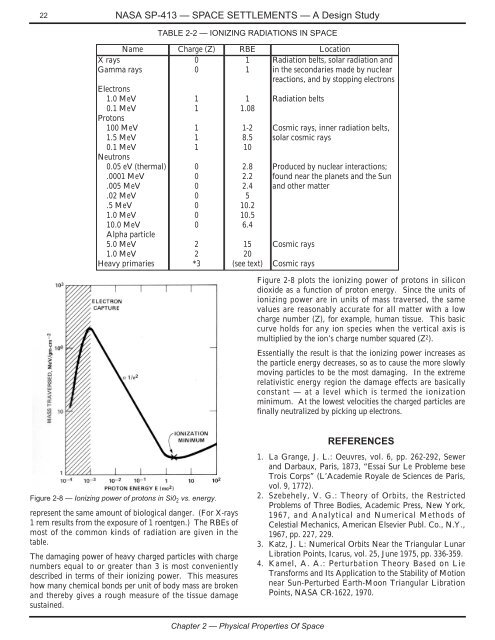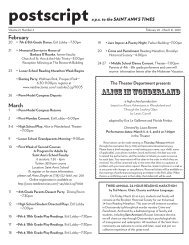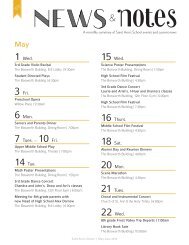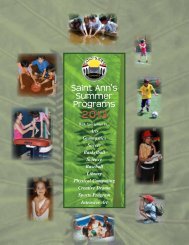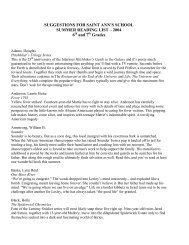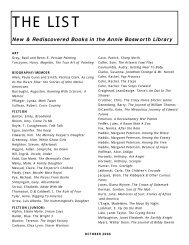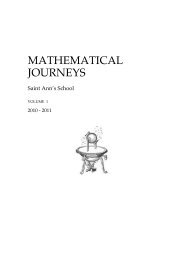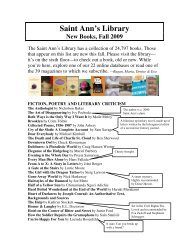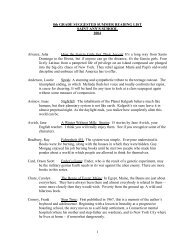NASA SP-413 Space Settlements - Saint Ann's School
NASA SP-413 Space Settlements - Saint Ann's School
NASA SP-413 Space Settlements - Saint Ann's School
Create successful ePaper yourself
Turn your PDF publications into a flip-book with our unique Google optimized e-Paper software.
22<br />
<strong>NASA</strong> <strong>SP</strong>-<strong>413</strong> — <strong>SP</strong>ACE SETTLEMENTS — A Design Study<br />
X rays<br />
Gamma rays<br />
TABLE 2-2 — IONIZING RADIATIONS IN <strong>SP</strong>ACE<br />
Name Charge (Z) RBE Location<br />
0<br />
1<br />
0<br />
1<br />
Electrons<br />
1.0 MeV<br />
0.1 MeV<br />
Protons<br />
100 MeV<br />
1.5 MeV<br />
0.1 MeV<br />
Neutrons<br />
0.05 eV (thermal)<br />
.0001 MeV<br />
.005 MeV<br />
.02 MeV<br />
.5 MeV<br />
1.0 MeV<br />
10.0 MeV<br />
Alpha particle<br />
5.0 MeV<br />
1.0 MeV<br />
Heavy primaries<br />
1<br />
1<br />
1<br />
1<br />
1<br />
0<br />
0<br />
0<br />
0<br />
0<br />
0<br />
0<br />
2<br />
2<br />
*3<br />
1<br />
1.08<br />
1-2<br />
8.5<br />
10<br />
2.8<br />
2.2<br />
2.4<br />
5<br />
10.2<br />
10.5<br />
6.4<br />
15<br />
20<br />
(see text)<br />
Radiation belts, solar radiation and<br />
in the secondaries made by nuclear<br />
reactions, and by stopping electrons<br />
Radiation belts<br />
Cosmic rays, inner radiation belts,<br />
solar cosmic rays<br />
Produced by nuclear interactions;<br />
found near the planets and the Sun<br />
and other matter<br />
Cosmic rays<br />
Cosmic rays<br />
Figure 2-8 plots the ionizing power of protons in silicon<br />
dioxide as a function of proton energy. Since the units of<br />
ionizing power are in units of mass traversed, the same<br />
values are reasonably accurate for all matter with a low<br />
charge number (Z), for example, human tissue. This basic<br />
curve holds for any ion species when the vertical axis is<br />
multiplied by the ion’s charge number squared (Z 2 ).<br />
Essentially the result is that the ionizing power increases as<br />
the particle energy decreases, so as to cause the more slowly<br />
moving particles to be the most damaging. In the extreme<br />
relativistic energy region the damage effects are basically<br />
constant — at a level which is termed the ionization<br />
minimum. At the lowest velocities the charged particles are<br />
finally neutralized by picking up electrons.<br />
Figure 2-8 — Ionizing power of protons in Si0 2 vs. energy.<br />
represent the same amount of biological danger. (For X-rays<br />
1 rem results from the exposure of 1 roentgen.) The RBEs of<br />
most of the common kinds of radiation are given in the<br />
table.<br />
The damaging power of heavy charged particles with charge<br />
numbers equal to or greater than 3 is most conveniently<br />
described in terms of their ionizing power. This measures<br />
how many chemical bonds per unit of body mass are broken<br />
and thereby gives a rough measure of the tissue damage<br />
sustained.<br />
REFERENCES<br />
1. La Grange, J. L.: Oeuvres, vol. 6, pp. 262-292, Sewer<br />
and Darbaux, Paris, 1873, “Essai Sur Le Probleme bese<br />
Trois Corps” (L’Academie Royale de Sciences de Paris,<br />
vol. 9, 1772).<br />
2. Szebehely, V. G.: Theory of Orbits, the Restricted<br />
Problems of Three Bodies, Academic Press, New York,<br />
1967, and Analytical and Numerical Methods of<br />
Celestial Mechanics, American Elsevier Publ. Co., N.Y.,<br />
1967, pp. 227, 229.<br />
3. Katz, J. L: Numerical Orbits Near the Triangular Lunar<br />
Libration Points, Icarus, vol. 25, June 1975, pp. 336-359.<br />
4. Kamel, A. A.: Perturbation Theory Based on Lie<br />
Transforms and Its Application to the Stability of Motion<br />
near Sun-Perturbed Earth-Moon Triangular Libration<br />
Points, <strong>NASA</strong> CR-1622, 1970.<br />
Chapter 2 — Physical Properties Of <strong>Space</strong>


